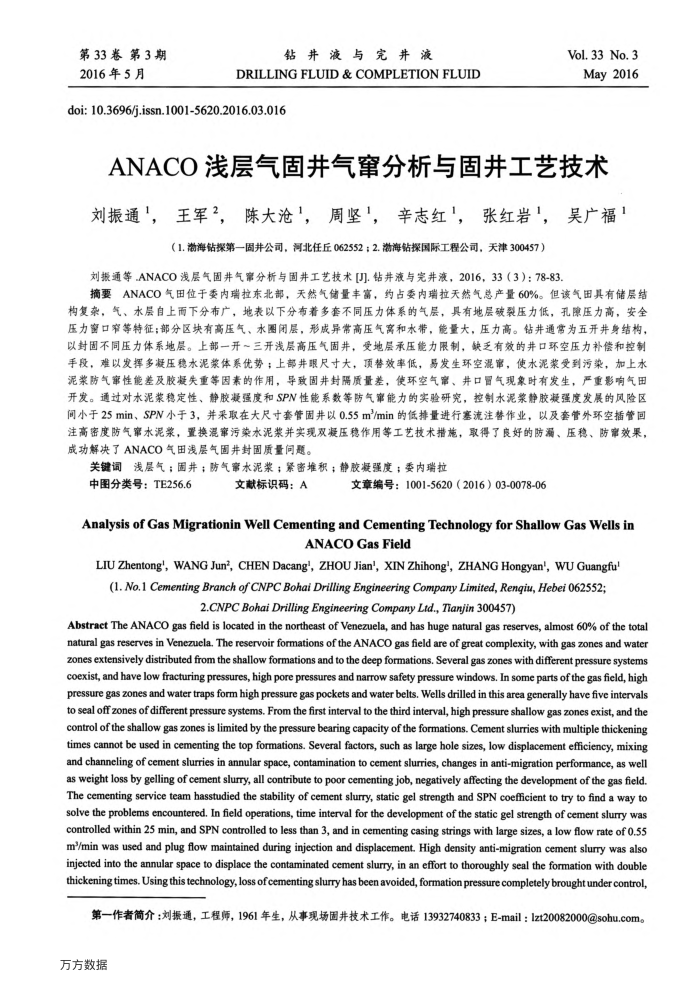ANACO浅层气固井气窜分析与固井工艺技术
内容简介
 第33卷第3期 2016年5月
第33卷第3期 2016年5月钻井液与完井液
DRILLINGFLUID&COMPLETIONFLUID
doi: 10.3696/j.issn.1001-5620.2016.03.016
Vol.33No.3 May2016
ANACO浅层气固井气窜分析与固井工艺技术刘振通,王军2,陈大沧,周坚,辛志红,张红岩,吴广福1
(1.徽海钻探第一固井公司,河北任丘062552;2.徽海钻探国际工程公司,天津300457)
刘报通等.ANACO浅层气固井气审分析与围井工艺技术[1].钻井液与完井液,2016,33(3):78-83.
摘要ANACO气田位于委内瑞拉东北部,天然气储量丰富,约占委内瑞拉天然气总产量60%。但该气田具有储层结构复杂,气、水层自上雨下分布广,地表以下分布着多套不同压力体系的气层,具有地层破裂压力低,孔隙压力高,安全压力窗口窄等特征;部分区块有高压气、水圈闭层,形成异常高压气高和水带,能量大,压力高。钻井通常为五开井身结构,
三开浅层高压气固井
以对固不同压力体系地层。上部一开~
手段,难以发挥多凝压稳水泥蒙体系优势:泥防气窜性能差及胶凝失重等因素的作用,
受地层承压能力限制,缺乏有效的井口环空压力补偿和控制
数率低:
易发生环空混窜,使水泥蒙受到污染,加上水
使环空气常、井口留气现象时有发生,产重影响气田
开发。通过对水泥蒙稳定性、静胶凝强度和SPN性能系数等防气宰能力的实验研究,控制水泥静胶凝强度发展的风险区间小于25min、SPN小于3,并采取在大尺寸套管固井以0.55m/min的低排量进行塞流注替作业,以及套管外环空插管回注高密度防气宰水泥浆,置换混审污荣水泥浆并实现双凝压稳作用等工艺技术措施,取得了良好的防漏、压稳、防窜效果,成功解决了ANACO气田浅层气固井封固质量间题。
关键词浅层气;固井;防气水泥浆;紧密堆积;静胶凝强度;委内瑞拉
中图分类号:TE256.6
文献标识码:A
文章编号:1001-5620(2016)03-0078-06
Analysis of Gas Migrationin Well Cementing and Cementing Technology for Shallow Gas Wells in
ANACOGasField
(1.No.1CementingBranch ofCNPCBohaiDrillingEngineeringCompany Limited, Renqiu,Hebei062552;
2.CNPCBohai Dilling Engineering Company Ltd, Tlanjin 300457)
Abstract The ANACO gas field is located in the northeast of Venezuela, and has huge natural gas reserves, almost 60% of the total natural gas reserves in Venezucla. The reservoir formations of the ANACO gas field are ofgreat complexity, with gas zones and water zones extensively distributed from the shallow formations and to the deep formations, Several gas zones with different pressure systems coexist, and have low fracturing pressures, high pore pressures and narrow safety pressure windows. In some parts of the gas field, high pressure gas zones and water traps form high pressure gas pockets and water belts. Wells dilled in this area generally have five intervals to seal off zones of different pressure systems. From the first interval to the third interval, high pressure shallow gas zones exist, and the controlofthe shallow gas zones is limited by the pressure bearing capacity ofthe formations. Cement sluries with multiple thickening times cannot be used in cementing thetopfomations. Severalfactors, such aslargehole sizes, low displacementficiency,mixing and channeling of cement slurries in annular space, contamination to cement slurries, changes in anti-migration performance, as well as weight loss by gelling of cement slurry, all contribute to poor cementing job, negatively affecting the development of the gas field. The cementing service team hasstudied the stability of cement slurry, static gel strength and SPN coeficient to try to find a way to solve the problems encountered. In field operations, time interval for the development of the static gel strength of cement slurry was controlled within 25 min, and SPN controlled to less than 3, and in cementing casing strings with large sizes, a low flow rate of 0.55 m/min was used and plug flow maintained during injection and displacement. High density anti-migration cement slurry was also injected into the annular space to displace the contaminated cement slurry, in an effort to thoroughly seal the formation with double thickening times. Using this technology, loss ofcementing slurry has been avoided, formation pressure completely brought under control,
第一作者简介:刘振通,工程师,1961年生,从事现场固井技术工作。电话13932740833;E-mail:lzt20082000@sohu.com 万方数据